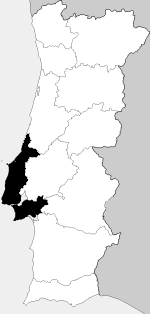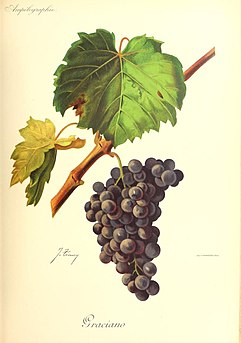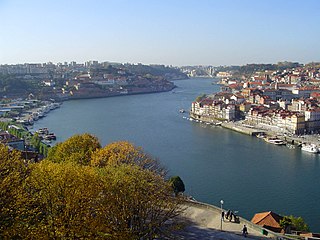
The Douro is one of the major rivers of the Iberian Peninsula, flowing from its source near Duruelo de la Sierra in Soria Province across northern-central Spain and Portugal to its outlet at Porto.
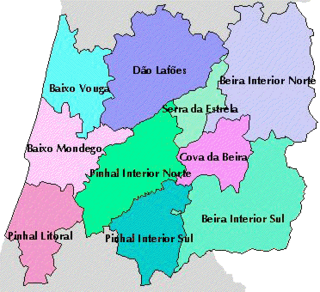
Dão is a Portuguese wine region situated in the Região Demarcada do Dão with the Dão-Lafões sub region of the Centro, Portugal. It is one of the oldest established wine regions in Portugal. Dão wine is produced in a mountainous region with a temperate climate, in the area of the Rio Mondego and Dão rivers in the north central region of Portugal. The region became a Denominação de Origem Controlada (DOC) appellation in 1990. The Dão region is the origin of the Touriga Nacional vine that is the principal component of Port wine.

Bento Gonçalves is a municipality located in the state of Rio Grande do Sul, Brazil. Created in 1875, it is one of the centers of the Italian immigration in Brazil. It is also known as the 'wine capital of Brazil' due to its vineyards and wine production. In 2016, its estimated population was 114,203 inhabitants.

Alentejo is a Portuguese wine region located in the Alentejo region of the country. The entire region is entitled to use the Vinho Regional designation Alentejano VR, while some areas are also classified at the higher Denominação de Origem Controlada (DOC) level under the designation Alentejo DOC. VR is similar to the French vin de pays and DOC to the French AOP. Located in the southern half of Portugal, the Alentejo region covers about a third of the country and is sparsely populated. In 2005, South Oregon University scientist Gregory V. Jones identified Alentejo as the world's most challenged wine region from a climate change perspective. The region is noted for it vast cork production but has in recent years garnered attention for its table wine production. Some producers of this region still do wine in great potteries as in Roman times.
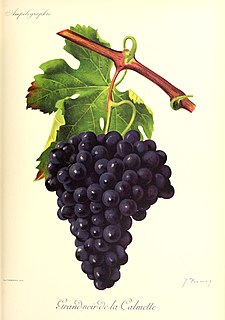
Grand Noir de la Calmette is a red teinturier grape variety that is a crossing of Petit Bouschet and Aramon noir created in 1855 by French grape breeder Henri Bouschet at his vineyard in Mauguio in the Hérault department. The grape was named after the breeding station Domaine de la Calmette. As a teinturier, Grand noir is often used to add color to wines that it is blended into but is paler than other choices such as Alicante Bouschet. The vine tends to bud late and has a high productivity but with some susceptibility to the viticultural hazard of powdery mildew.
The denominação de origem controlada is the system of protected designation of origin for wines, cheeses, butters, and other agricultural products from Portugal.
Alenquer is a Portuguese wine region centered on the town of Alenquer in the Lisboa wine region. The region is designated as Denominação de Origem Controlada (DOC) after it was promoted from its former Indicação de Proveniencia Regulamentada (IPR) status. Located in a valley in the district of Lisboa, wine grapes are able to ripen easily and produce full bodied red wines that have a spicy, peppery aroma. The white wines tend to be dry with a creamy mouthfeel.
Castelo Rodrigo is a Portuguese wine region centered on the town of Figueira de Castelo Rodrigo in the wider Beiras wine region south of the Douro river. Castelo Rodrigo was initially a separate Indicação de Proveniencia Regulamentada (IPR) region, but in 2005, it became one of three subregions of the Beira Interior DOC, which has the higher Denominação de Origem Controlada (DOC) status. Its name may still be indicated together with that of Beira Interior, as Beira Interior-Castelo Rodrigo.
Óbidos is a Portuguese wine region centered on the town of Óbidos in the Lisboa region. The region is designated as Denominação de Origem Controlada (DOC) after it was promoted from its former Indicação de Proveniencia Regulamentada (IPR) status in 2006.
Torres Vedras is a Portuguese wine region centered on the town of Torres Vedras in the Lisboa wine region. The region is designated as Denominação de Origem Controlada (DOC) after it was promoted from its former Indicação de Proveniência Regulamentada (IPR) status. The high yields produced in this region have historically be used by bulk wine producers for inexpensive vindo de mesa wines. The area was known by the shorthand "Torres" until Spanish wine producer Miguel A. Torres objected to the association with the region.
Borba is a Portuguese wine region centered on the Borba Municipality in the Alentejo region. The region was initially an Indicação de Proveniencia Regulamentada (IPR) region, then elevated to Denominação de Origem Controlada (DOC) status. In 2003, it became one of eight subregions of the Alentejo DOC. Its name may still be indicated together with that of Alentejo, as Alentejo-Borba.

Bucelas is a Portuguese wine-region located in the Lisboa wine-region. The region has Portugal's highest wine classification as a Denominação de Origem Controlada (DOC). Located south of the Arruda DOC, the region is noted for its potential for cool fermentation white wine production. Vineyards in the area are planted on predominantly loam soils. The white wines of Bucelas became widely popular during the Elizabethan era in England and again during the Victorian age. In London the wines were sometimes described as Portuguese hock because of their similarities to the German Rieslings from the Rhine. Urban sprawl in the 20th century has drastically reduced viticulture in the area, located north of the Portuguese capital city, Lisbon.
Redondo is a Portuguese wine region centered on the Redondo municipality in the Alentejo region. The region was initially an Indicação de Proveniencia Regulamentada (IPR) region, then elevated to Denominação de Origem Controlada (DOC) status. In 2003, it became one of eight subregions of the Alentejo DOC. Its name may still be indicated together with that of Alentejo, as Alentejo-Redondo.

Algarve is a Portuguese wine region covering the same areas as its namesake region. The region is classified as a Vinho Regional (VR), a designation similar to a French vin de pays region. Located on the southern coast of Portugal, the region's wine industry is driven by the local tourist economy with very few wines being exported.

Tejo, until 2009 named Ribatejo, is a Portuguese wine region covering the same areas as the Ribatejo Province. It takes its name from the river Tejo (Tagus). The entire region is entitled to use the Vinho Regional designation Tejo VR, while some areas are also classified at the higher Denominação de Origem Controlada (DOC) level under the designation DoTejo DOC. VR is similar to the French vin de pays and DOC to the French AOC.


